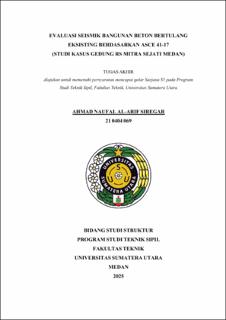Evaluasi Seismik Bangunan Beton Bertulangan Eksisting Berdasarkan ASCE 41-17 (Studi Kasus Gedung RS Mitra Sejati Medan)
Seismic Evaluation of Existing Reinforced Concrete Building Based on ASCE 41-17 (Case Study: Mitra Sejati Hospital Building, Medan)

Date
2025Author
Siregar, Ahmad Naufal Al-Arif
Advisor(s)
Handana, Muhammad Agung Putra
Metadata
Show full item recordAbstract
Indonesia is located within the Pacific Ring of Fire, making it highly vulnerable to seismic hazards. One of the key efforts to reduce the risk of earthquake-induced damage is by evaluating existing building structures using established standards. One widely adopted standard is ASCE 41-17 (American Society of Civil Engineers), which plays a significant role in assessing the seismic performance of building structures. This standard applies a performance-based design approach, with evaluation levels ranging from Tier 1 to Tier 3, and performance objectives including Immediate Occupancy (IO), Life Safety (LS), and Collapse Prevention (CP)
This study focuses on the structural assessment of Building C at Mitra Sejati Hospital in Medan, constructed in 2001 with five floors. The structure was originally designed based on SNI 03-1726-1989, which was applicable at the time. However, with the adoption of the updated SNI 1726:2019 and the need for more accurate seismic evaluation, the building requires reassessment using the latest methods
The assessment was conducted using the ASCE 41-17 guidelines through a multi-tiered approach: Tier 1 (Screening) and Tier 2 (Deficiency-Based Evaluation). Tier 1 involved a Quick Check Analysis, examining the structural configuration and performance using a Systematic Structural Checklist. The results indicated that several structural elements fell under Noncompliant or Unknown categories, necessitating further evaluation under Tier 2. In this stage, the Linear Dynamic Procedure (LDP) was used to assess structural responses such as displacement, shear forces, and moment under seismic loads.
The Tier 2 analysis showed that the structural components were only capable of achieving Life Safety (LS) and Immediate Occupancy (IO) performance levels in certain areas, indicating that the building does not fully comply with current safety requirements for strong earthquake events. Therefore, strengthening strategies and full implementation of ASCE 41-17 are essential to ensure the structural safety of the building in the event of future seismic activity.
Collections
- Undergraduate Theses [1609]
